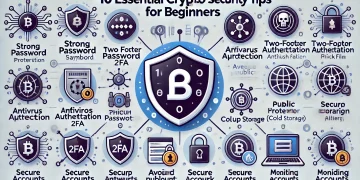Table of Contents
- Introduction
- Understanding ICOs and IEOs
- The State of ICOs and IEOs in 2024
- Top ICOs of 2024
- Top IEOs of 2024
- Trends in ICOs and IEOs in 2024
- How to Evaluate ICOs and IEOs
- Risks and Challenges
- Regulatory Landscape
- Future Outlook
- Conclusion
Introduction
As we navigate through 2024, the cryptocurrency landscape continues to evolve, with Initial Coin Offerings (ICOs) and Initial Exchange Offerings (IEOs) playing a significant role in fundraising for blockchain and crypto projects. These token sale methods have matured since their inception, adapting to regulatory challenges and market demands.
This comprehensive review aims to highlight the top ICOs and IEOs of 2024, providing insights into the most promising projects, current trends, and the overall state of token sales in the crypto space. Whether you’re an investor looking for opportunities, a developer seeking funding models, or simply a crypto enthusiast keeping up with the latest developments, this guide will offer valuable information to navigate the exciting world of ICOs and IEOs in 2024.
Understanding ICOs and IEOs
Before diving into the top offerings of 2024, let’s refresh our understanding of ICOs and IEOs.
What are ICOs?
Initial Coin Offerings (ICOs) are a fundraising method used by cryptocurrency projects to raise capital. In an ICO, a project sells a portion of its cryptocurrency tokens to early backers in exchange for other cryptocurrencies (usually Bitcoin or Ethereum) or fiat currency.
Key characteristics of ICOs include:
- Direct sales from the project to investors
- Often open to the general public
- Tokens are typically sold before the project is fully developed
- Less regulatory oversight compared to traditional fundraising methods
What are IEOs?
Initial Exchange Offerings (IEOs) are a evolution of the ICO model, where the token sale is conducted through a cryptocurrency exchange platform. The exchange acts as a middleman between the project and investors.
Key characteristics of IEOs include:
- Token sales are conducted on exchange platforms
- Usually only available to users of the specific exchange
- The exchange vets projects before listing
- Often perceived as more secure than ICOs due to exchange involvement
ICOs vs IEOs: Key Differences
While both ICOs and IEOs are methods of token distribution, they differ in several key aspects:
- Platform: ICOs are conducted independently by projects, while IEOs are hosted on exchange platforms.
- Vetting Process: IEOs undergo vetting by the exchange, potentially reducing the risk of scams.
- Accessibility: ICOs are generally open to all, while IEOs are often limited to exchange users.
- Trust Factor: IEOs leverage the reputation of the hosting exchange.
- Marketing: IEOs benefit from the exchange’s user base and marketing efforts.
- Listing: Tokens from IEOs are typically listed on the hosting exchange immediately after the sale.
The State of ICOs and IEOs in 2024
As we review the top ICOs and IEOs of 2024, it’s important to understand the current state of these fundraising methods:
- Maturation: Both ICOs and IEOs have matured significantly since their inception, with more sophisticated projects and investor expectations.
- Regulatory Clarity: Many jurisdictions have developed clearer regulations around token sales, providing more certainty for projects and investors.
- Quality Over Quantity: There are fewer ICOs and IEOs compared to the 2017-2018 boom, but the quality of projects has generally improved.
- Integration with DeFi: Many token sales now integrate with or focus on Decentralized Finance (DeFi) applications.
- Increased Scrutiny: Investors have become more discerning, demanding stronger fundamentals and clearer use cases for tokens.
- Globalization: While regulatory challenges remain, token sales have become more global, with projects and investors participating from various countries.
With this context in mind, let’s explore the top ICOs and IEOs of 2024.
Top ICOs of 2024
ICO 1: [Name]
- Project Overview: [Brief description of the project]
- Token: [Token name and symbol]
- ICO Date: [Start and end dates]
- Funds Raised: [Amount raised]
- Key Features:
- [Feature 1]
- [Feature 2]
- [Feature 3]
- Team: [Brief overview of key team members]
- Roadmap: [Key milestones]
- Why It Stands Out: [Reasons why this ICO is noteworthy]
ICO 2: [Name]
[Follow the same structure as ICO 1]
ICO 3: [Name]
[Follow the same structure as ICO 1]
ICO 4: [Name]
[Follow the same structure as ICO 1]
ICO 5: [Name]
[Follow the same structure as ICO 1]
Top IEOs of 2024
IEO 1: [Name]
- Project Overview: [Brief description of the project]
- Token: [Token name and symbol]
- IEO Date: [Start and end dates]
- Hosting Exchange: [Name of the exchange]
- Funds Raised: [Amount raised]
- Key Features:
- [Feature 1]
- [Feature 2]
- [Feature 3]
- Team: [Brief overview of key team members]
- Roadmap: [Key milestones]
- Why It Stands Out: [Reasons why this IEO is noteworthy]
IEO 2: [Name]
[Follow the same structure as IEO 1]
IEO 3: [Name]
[Follow the same structure as IEO 1]
IEO 4: [Name]
[Follow the same structure as IEO 1]
IEO 5: [Name]
[Follow the same structure as IEO 1]
Trends in ICOs and IEOs in 2024
As we analyze the top ICOs and IEOs of 2024, several trends become apparent:
- Focus on Real-World Applications: Many successful projects are focusing on solving real-world problems rather than purely speculative use cases.
- Integration with Existing Ecosystems: Projects that integrate with or enhance existing blockchain ecosystems are gaining traction.
- Sustainability and Energy Efficiency: There’s an increased emphasis on environmentally sustainable blockchain solutions.
- Regulatory Compliance: Successful projects are prioritizing regulatory compliance from the outset.
- Cross-Chain Interoperability: Many projects are focusing on enabling interoperability between different blockchain networks.
- AI and Blockchain Convergence: The integration of artificial intelligence with blockchain technology is a growing trend.
- Privacy-Focused Solutions: With increasing concerns about data privacy, projects offering enhanced privacy features are gaining attention.
- Tokenization of Real-World Assets: Projects facilitating the tokenization of traditional assets are becoming more prominent.
How to Evaluate ICOs and IEOs
When considering participation in an ICO or IEO, it’s crucial to conduct thorough due diligence. Here are some key factors to evaluate:
- Team: Research the background and experience of the team members.
- Project Viability: Assess the problem the project aims to solve and the viability of its solution.
- Technology: Evaluate the technical aspects of the project, including its blockchain architecture and scalability plans.
- Token Economics: Understand the token distribution, vesting schedules, and the token’s utility within the ecosystem.
- Roadmap: Review the project’s development roadmap and assess its feasibility.
- Community and Partnerships: Gauge the strength of the project’s community and any strategic partnerships.
- Legal and Regulatory Compliance: Ensure the project is compliant with relevant regulations.
- Market and Competition: Analyze the target market and competitive landscape.
- Transparency: Look for projects that are transparent about their development process and use of funds.
- Security: For IEOs, also evaluate the reputation and security measures of the hosting exchange.
Risks and Challenges
While ICOs and IEOs can offer exciting investment opportunities, they also come with significant risks:
- Market Volatility: The cryptocurrency market is highly volatile, which can affect token values.
- Regulatory Risks: Changing regulations can impact the legality and operation of projects.
- Technical Risks: Smart contract vulnerabilities or other technical issues can lead to loss of funds.
- Scams and Fraud: Despite improvements, the ICO/IEO space still attracts fraudulent projects.
- Project Failure: Many projects fail to deliver on their promises or gain market traction.
- Lack of Liquidity: Some tokens may have low trading volumes, making it difficult to sell.
- Information Asymmetry: Projects may not disclose all relevant information to investors.
Regulatory Landscape
The regulatory environment for ICOs and IEOs continues to evolve:
- United States: The SEC has increased scrutiny of token sales, often viewing them as securities offerings.
- European Union: The EU’s Markets in Crypto-Assets (MiCA) regulation provides a comprehensive framework for crypto assets.
- Asia: Countries like Singapore and Japan have developed clear regulatory frameworks for token sales.
- Global Coordination: There are increasing efforts for international coordination on crypto regulations.
Investors should always be aware of the regulatory status of ICOs and IEOs in their jurisdiction.
Future Outlook
Looking ahead, several factors are likely to shape the future of ICOs and IEOs:
- Increased Institutionalization: More involvement from traditional financial institutions and venture capital firms.
- Regulatory Clarity: Clearer regulations could provide more certainty for projects and investors.
- Technology Advancements: Improvements in blockchain technology could enable new types of token sales and use cases.
- Market Cycles: The overall crypto market sentiment will continue to influence the success of token sales.
- Evolution of Funding Models: New hybrid models combining elements of ICOs, IEOs, and traditional funding may emerge.
Conclusion
The landscape of ICOs and IEOs in 2024 reflects a maturing market, with high-quality projects addressing real-world problems and adhering to regulatory requirements. While the frenzy of the early ICO boom has subsided, token sales remain a vital part of the cryptocurrency ecosystem, providing funding for innovative blockchain projects and investment opportunities for savvy participants.
As always, potential investors should approach ICOs and IEOs with caution, conducting thorough research and understanding the associated risks. The projects highlighted in this review represent some of the most promising offerings of 2024, but they are just a snapshot of a dynamic and rapidly evolving space.
As we look to the future, it’s clear that token sales, in various forms, will continue to play a significant role in funding blockchain innovation. By staying informed about market trends, regulatory developments, and best practices for evaluation, participants can navigate this exciting frontier of finance and technology.
Remember, the world of ICOs and IEOs is fast-paced and ever-changing. Always stay updated with the latest information and consult with financial advisors before making investment decisions.






























